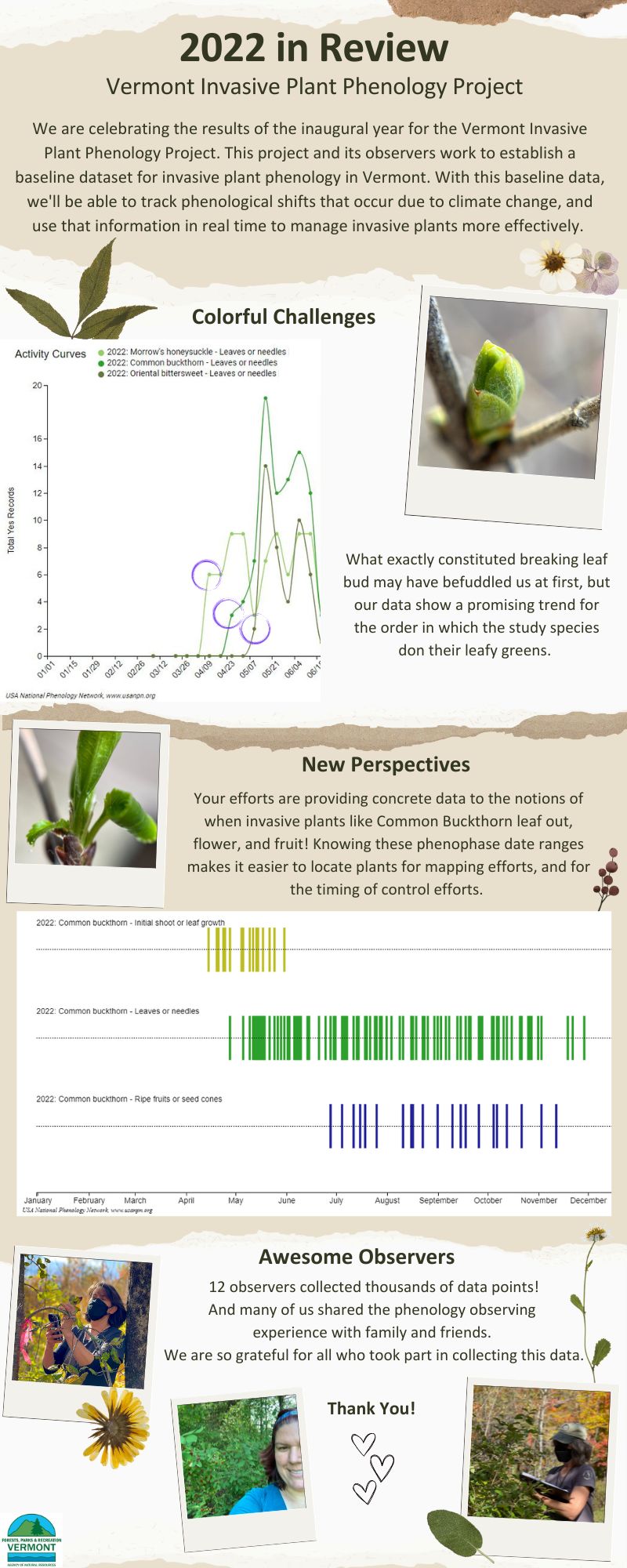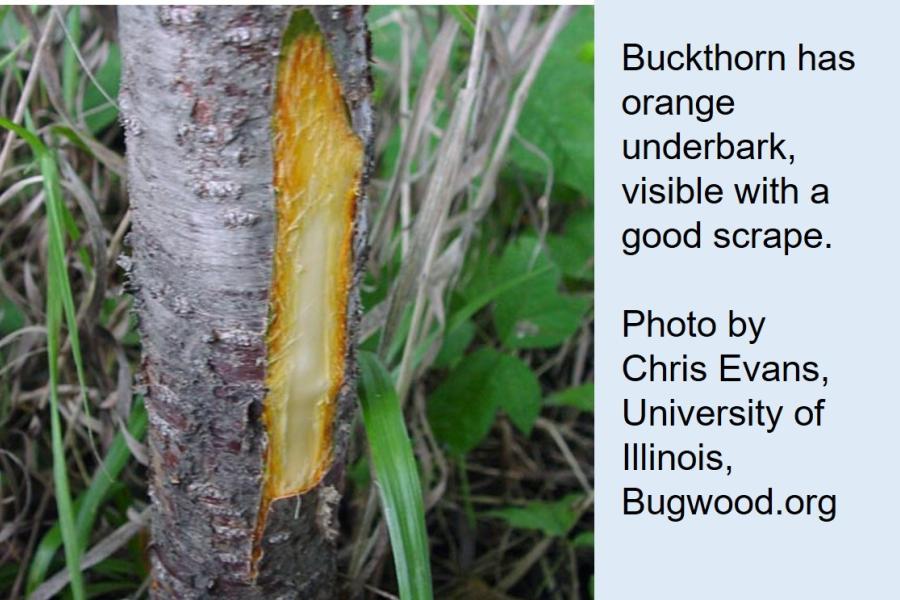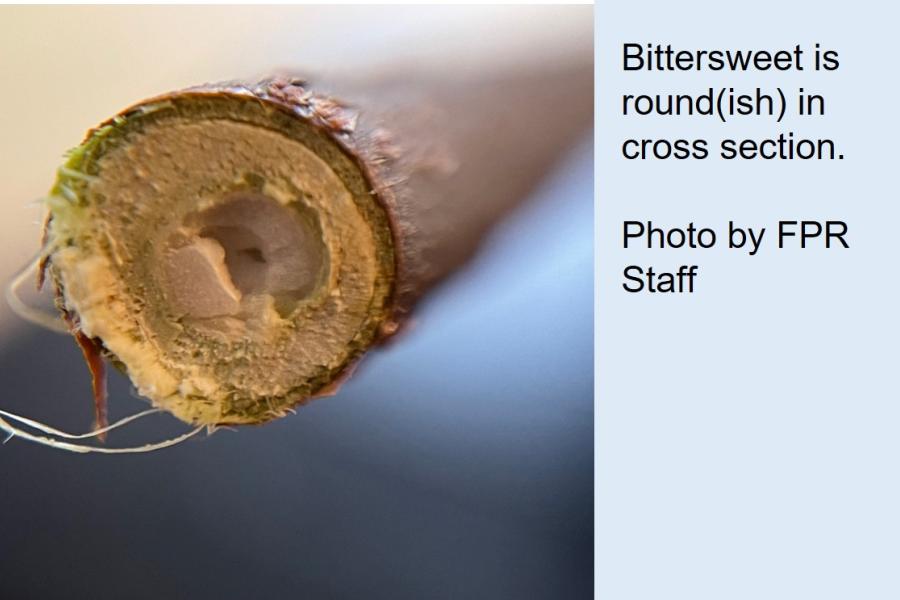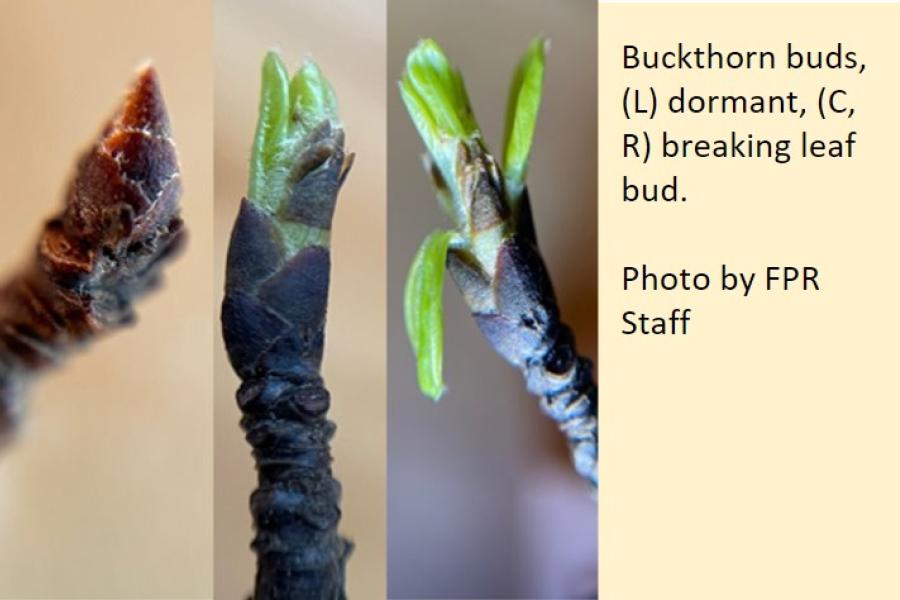Project Context
The Vermont Invasive Plant Phenology Project (VIPPP) is a project establishing a baseline dataset (there’s currently an absence of strong, widely available data!) for invasive plant phenology in Vermont. With this baseline data, we’ll be able to track phenological shifts that occur due to climate change, and use the data in real time to help plan for and manage invasive plants effectively. Project participants are utilizing National Phenology Network's database and their online mapping tool, Nature's Notebook to collect valuable information for managing state lands, as well as how land stewards, communities and landowners plan, budget, and implement terrestrial invasive plant control efforts.
Vermont Department of Forests, Parks & Recreation would like to acknowledge the financial and technical support provided by the USDA Forest Service, Northeastern Area State and Private Forestry that enables us to run projects and provide outreach such as this.
Getting Started
-
Click here to access all our project training resources*
*once you complete the training, you can return to this page and its trainings as frequently as you need
Quick Access to Project Info
- Project FAQ
- Community Blog
- Monitoring Protocols
- Field ID of Woody Invasive Plants
- Invasive Plant Phenophases
- Phenophase Photo Guides
- Phenophase Practice
- Datasheets
- Additional Helpful Links
- Observer Schedules by Site
- Site Details
- Year in Review
- Current Phenophases & Photos
-
Project FAQ
Coming soon! As this project grows, and questions arise, we'll post them and the answers here.
Monitoring Protocols
- Click here to go to detailed Site Selection summary
- FPR protocols
- Site Selection
- Status Monitoring (Observing & Recording)
- National Phenology Network's Phenology Protocols & their Definitions
- 'How to Observe' handbook for Nature's Notebook
-
Field ID of Woody Invasive Plants
- Click here to access our field ID guide, which includes Lonicera, Rhamnus, and Celastrus.
- Click here and click here (or click here!) to learn how to tell Lonicera morrowii apart from other invasive honeysuckles
- Quick review for distinguishing Lonicera morrowii from other invasive Lonicera
Invasive Plant Phenophases
- Click here to check out National Phenology Network's Botany Primer or click here to check out their Phenophase Primer for Plants
- Check out the species profile pages for:
Summary of relevant phenophases.
- Leaves
-
- Breaking leaf bud: "One or more breaking leaf buds are visible on the plant. A leaf bud is considered "breaking" once a green leaf tip is visible at the end of the bud, but before the first leaf from the bud has unfolded to expose the leaf stalk (petiole) or leaf base."
- HINT: What this looks like is different for each of our species. With Lonicera and Celastrus, look for vertical growth (upwards) occurring after you see lateral growth (sideways) with buds swelling, and the presence of leaf mid-rib and veins. Their leaf tips will likely be dark like the scales, but will grow upwards, whereas the scales won't (though they may expand sideways to allow for bud swell). This is tricky to see for Celastrus as the bud swell will be both sideways and upwards before leaves are seen - in this case watch for leaf midrib and veins. For Rhamnus, looking for green leaf tips is sufficient.
- Leaves: "One or more live, unfolded leaves are visible on the plant. A leaf is considered "unfolded" once its entire length has emerged from a breaking bud, stem node or growing stem tip, so that the leaf stalk (petiole) or leaf base is visible at its point of attachment to the stem. Do not include fully dried or dead leaves."
- Increasing leaf size: "A majority of leaves on the plant have not yet reached their full size and are still growing larger. Do not include new leaves that continue to emerge at the ends of elongating stems throughout the growing season."
- Colored leaves: "One or more leaves show some of their typical late-season color, or yellow or brown due to drought or other stresses. Do not include small spots of color due to minor leaf damage, or dieback on branches that have broken. Do not include fully dried or dead leaves that remain on the plant."
- Falling leaves: "One or more leaves with typical late-season color, or yellow or brown due to other stresses, are falling or have recently fallen from the plant. Do not include fully dried or dead leaves that remain on the plant for many days before falling."
- Breaking leaf bud: "One or more breaking leaf buds are visible on the plant. A leaf bud is considered "breaking" once a green leaf tip is visible at the end of the bud, but before the first leaf from the bud has unfolded to expose the leaf stalk (petiole) or leaf base."
-
- Flowers
-
- Flowers or flower bud: "One or more fresh open or unopened flowers or flower buds are visible on the plant. Include flower buds or inflorescences that are swelling or expanding, but do not include those that are tightly closed and not actively growing (dormant). Also do not include wilted or dried flowers."
- Open flowers: "One or more open, fresh flowers are visible on the plant. Flowers are considered "open" when the reproductive parts (male stamens or female pistils) are visible between or within unfolded or open flower parts (petals, floral tubes or sepals). Do not include wilted or dried flowers."
-
- Fruit
-
- Fruits: "One or more fruits are visible on the plant. For more details see individual Target Species profile pages on National Phenology Network website."
- Ripe fruits: "One or more ripe fruits are visible on the plant. For more details see individual Target Species profile pages on National Phenology Network website."
- Recent fruit or seed drop: "One or more mature fruits or seeds have dropped or been removed from the plant since your last visit. Do not include obviously immature fruits that have dropped before ripening, such as in a heavy rain or wind, or empty fruits that had long ago dropped all of their seeds but remained on the plant."
-
-
Phenophase photo guides
- Lonicera morrowii
- Rhamnus cathartica (coming soon!)
- Celastrus orbiculatus (coming soon!)
Phenophase practice
- Leaves
- Flowers
- Fruit
- Flickr results for Lonicera morrowii
- Flickr results for Rhamnus cathartica
- Flickr results for Celastrus orbiculatus
Datasheets
If you need to use a datasheet instead of the app, here's important information:
- Access and print datasheets
- Click here to learn how to transcribe data from paper to the website
- Want to label your plants with more than the aluminum tag? Here is a printable label document complete with QR code that you can use for two standard sizes of garden signs.
Additional helpful links
- BudBuds Podcast (project leads Elizabeth & Lina will provide seasonally appropriate tidbits in a *hopefully* entertaining way)
- Observing at a group site (our project is considered a group site)
- Nature's Notebook Nuggets (user submitted questions answered by USA-NPN's staff)
- FAQ for Nature's Notebook
- Observing when unsure of the species (for our project, you may not know which Lonicera you have until leaves emerge)
- USA-NPN's publications page
Observer Schedules by site
-
Last updated: 03/30/2022
Study area schedules to be determined soon. Current line up of observers:
-
Study Area 1 - TBD for 2023
Study Area 3 - TBD for 2023
Study Area 4 - TBD for 2023
Study Area 5 - TBD for 2023
Site details
-
Last updated: 02/25/2022
Site Maps
(coming soon)
-
Site Permissions:
-
Study Area 1 - This is a state park. Drive through main entrance and announce self to staff at contact station, let them know what you are doing, who you are doing it for, how long you'll be there, and where you intend to be.
-
Study Area 3 - This is a community park. The trails are free use to the public, you do not need to announce yourself to the staff. The trails are accessible from the parking lot. If it is your first time observing here, you may find it a kind gesture to introduce yourself to staff at the headquarter office and let them know what you are doing, and who you are doing it for.
-
Study Area 4 - The trails are free use to the public, you do not need to announce yourself to the staff. The trails are accessible from the parking lot. If it is your first time observing here, you may find it a kind gesture to introduce yourself to staff at the museum and let them know what you are doing, and who you are doing it for.
-
Study Area 5 - The forest is owned by the St. Johnsbury Academy Trustees, so it not freely open to the public. This is their "field campus", and we have been granted permission by the St. Johnsbury Academy Director of Facilities to establish our study sites and access the land for monitoring.
-
Site Access:
-
Study Area 1 - Main parking lot near day use. Can park and walk to access sites.
-
Study Area 3 - There is one main parking lot near the headquarter office. To leave prime spots for visitors, please park in back lot (hidden behind hedgerow).
-
Study Area 4 - There is one main parking lot near the museum. To leave prime spots for visitors, please park at far end of lot away from the building.
-
Study Area 5 - (coming soon!)
-
Site Selection:
- If you are responsible for setting up the sites in your assigned study area, please click here for the protocol.
- For more information about "what is a site" in the broader context of Nature's Notebook, click here.
- Location data for each site and each plant is important for Study Area Leads to collect
- This data will be used by project coordinators to create the sites and specific plants you'll use in Nature's Notebook!
- These are group "shared sites" and plants, so need to be added to our project, not your personal Nature's Notebook sites
- Once project coordinators add them to the project, you'll be able to see the sites and plants on your Nature's Notebook Observation Deck
- Still curious? Here's a good explanation with pictures!
- Need a refresher on how to collect location data with your phone? Click here for a video tutorial (1 min 51 sec).
Year in REview
- Last updated: 04/11/2023

Current Phenophases & Photos
- Last updated: 04/11/2023




